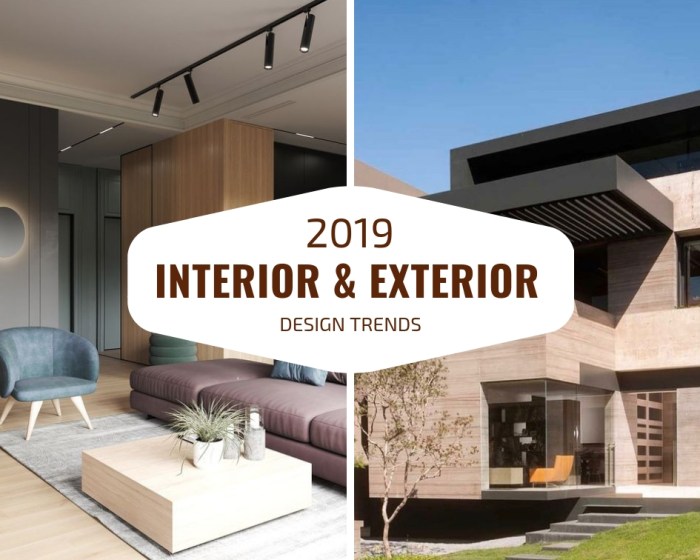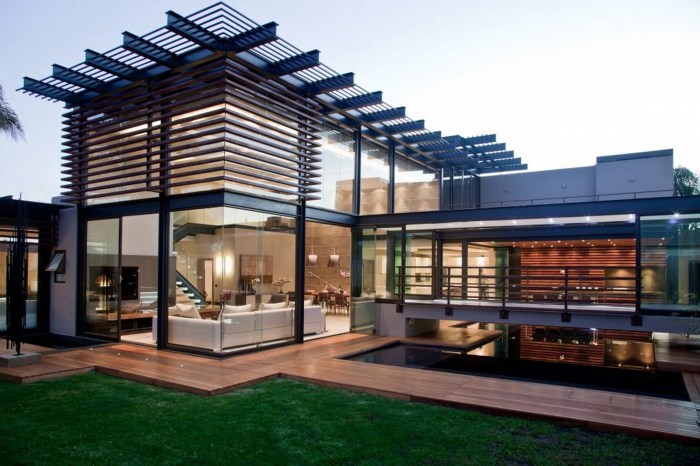Interior and Exterior Design: Creating Harmony Inside and Out

Exploring the dynamic interplay between interior and exterior design opens up a world of creativity and innovation. From color palettes to architectural elements, this topic delves into the intricacies of creating spaces that not only look beautiful but also function seamlessly.
From the impact of lighting to the use of sustainable materials, the fusion of interior and exterior design offers a holistic approach to crafting inviting and visually appealing environments.
Interior Design

Interior design plays a crucial role in creating comfortable and visually appealing spaces within homes or commercial buildings. It involves the selection of colors, furniture, lighting, and layout to enhance the overall aesthetics and functionality of a room.
Role of Color Palettes
Color palettes are essential in interior design as they set the mood and atmosphere of a space. Warm tones like reds, oranges, and yellows can create a cozy and inviting feel, while cool tones like blues and greens evoke a sense of calmness.
Neutral colors such as whites, grays, and browns provide a versatile backdrop for accent colors to pop and create visual interest.
Importance of Lighting
Lighting is a key element in interior design as it not only illuminates a space but also contributes to the ambiance. Natural light can make a room feel bright and spacious, while strategically placed artificial lighting fixtures can highlight architectural features or create a cozy atmosphere in the evening.
Proper lighting design can enhance the functionality and aesthetics of a room.
Impact of Furniture Layout
The layout of furniture in a room can significantly impact the flow and functionality of the space. A well-thought-out furniture arrangement can optimize traffic flow, create designated areas for different activities, and maximize the use of available space. It is essential to consider the scale, proportion, and functionality of furniture pieces when designing the layout of a room.
Comparison of Interior Design Styles
Various interior design styles, such as modern, traditional, and minimalist, offer different aesthetics and principles for creating cohesive spaces. Modern design emphasizes clean lines, minimalism, and the use of industrial materials, while traditional design focuses on elegance, symmetry, and classic furniture pieces.
Minimalist design embraces simplicity, neutral colors, and a clutter-free environment. Each style has its unique characteristics and appeal, catering to different tastes and preferences.
Exterior Design
Exterior design plays a crucial role in creating a visually appealing and functional space. It involves the use of various elements to enhance the aesthetic appeal of a building's exterior.Landscaping is a key component in enhancing the exterior aesthetics of a building.
By strategically designing and maintaining gardens, lawns, trees, and other outdoor elements, a building's exterior can be transformed into a welcoming and attractive space. Landscaping not only adds beauty but also helps improve the overall environment by providing shade, reducing noise pollution, and promoting biodiversity.
Use of Sustainable Materials
Sustainable materials are increasingly being used in exterior design to minimize environmental impact and promote eco-friendly practices. Examples of sustainable materials include reclaimed wood, recycled metal, bamboo, and green roofs. These materials not only reduce carbon footprint but also contribute to the overall sustainability of the building.
Significance of Architectural Elements
Architectural elements such as windows, doors, and facades play a significant role in exterior design
Influence of Climate
The climate of a region has a profound impact on exterior design choices. In hot climates, buildings are often designed with shading devices, high thermal mass materials, and natural ventilation to reduce energy consumption and maintain comfort. In colder climates, insulation, air sealing, and efficient heating systems are prioritized to ensure energy efficiency and occupant comfort.
Integration of Interior and Exterior Design

Creating a seamless transition between interior and exterior spaces is essential for a cohesive design that enhances the overall aesthetic and functionality of a space. By carefully considering elements such as materials, colors, and lighting, designers can blur the boundaries between indoor and outdoor areas, creating a harmonious flow between the two.
Biophilic Design and Connection between Interior and Exterior Environments
Biophilic design is a concept that focuses on incorporating elements of nature into built environments to improve the well-being of occupants. By integrating natural materials, textures, and patterns, as well as maximizing natural light and views of greenery, designers can create a strong connection between interior and exterior spaces, promoting a sense of tranquility and harmony.
Harmonizing Color Schemes
To ensure a cohesive look between interior and exterior design elements, it is important to harmonize color schemes. Choose a color palette that complements the surrounding environment and consider using similar hues or tones both indoors and outdoors. This will help create a seamless transition and enhance the overall visual appeal of the space.
Consideration of Sightlines
When designing both interior and exterior spaces, it is crucial to consider sightlines to ensure a sense of continuity and connection between the two areas. By strategically placing windows, doors, and focal points, designers can create visual pathways that draw the eye from inside to outside and vice versa, enhancing the overall flow and experience of the space.
Summary
As we conclude our exploration of interior and exterior design, it becomes clear that the key to truly remarkable spaces lies in the seamless integration of elements from both realms. By considering every detail, from color schemes to landscaping, we can transform ordinary spaces into extraordinary experiences.
Expert Answers
How does furniture layout impact the flow of a room?
Furniture layout can either enhance or hinder the flow of a room. By strategically placing furniture, you can create a sense of balance and harmony in the space.
What is biophilic design and how is it applied in interior and exterior spaces?
Biophilic design incorporates elements of nature into the built environment to promote well-being. It can be applied through the use of natural materials, ample natural light, and indoor plants.
Why is it important to harmonize color schemes between interior and exterior design elements?
Harmonizing color schemes creates a cohesive look and feel throughout a property, enhancing the overall aesthetic appeal and creating a sense of unity.
How can sightlines be considered when designing both interior and exterior spaces?
Considering sightlines ensures that views from one space to another are visually appealing and uninterrupted, creating a sense of continuity and openness.

